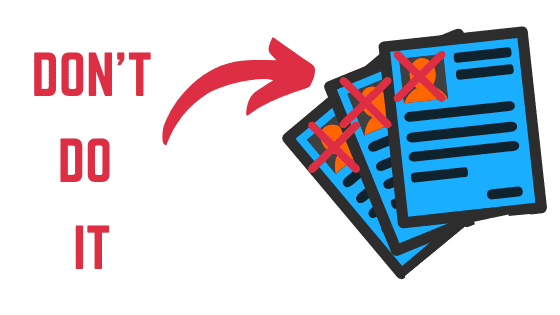No, You Should NOT Have a Picture on Your Resume (In Most Countries, At Least)

Just… don’t. Unless you live in one of the countries where it’s customary, including a photo on a resume is not a good idea. Find out why a resume with pictures is problematic.
By: Grace Mitchell | Contributor for Let’s Eat, Grandma
Look at you go with your updated LinkedIn profile.
You revamped your About section, threw out mention of jobs you held 20+ years ago, and even splurged on a professional headshot courtesy of your favorite photographer friend. Your photo now says cute, confident, and employable.
Your friend really got your angles, so you’re thinking of using the photo to add a pop of personality to your resume, too. After all, the template you downloaded even leaves space for one.
Ready for more job search help?
Sign up for a free Senior Writer Resume Critique to see what's holding you back from landing interviews. One of our top professional resume writers will give you personalized feedback on the top 3 items you can improve based on our expert practices!
But wait — not so fast!
Generally speaking, you should never submit a resume with pictures when applying to jobs in North America. In fact, if a US employer requests a photo of you this early in the hiring process (unless you’re applying to a job in the entertainment industry), this should raise a red flag.
According to the US Equal Employment Opportunity Commission, “employers should not ask for a photograph of an applicant. If needed for identification purposes, a photograph may be obtained after an offer of employment is made and accepted.” What’s the big deal, though?
A Resume With Pictures vs Discrimination
When a resume includes a photo of the applicant, this opens the door for discrimination based on the applicant’s race, gender, age, physical appearance, and ability. A resume photo allows the hiring manager to consider not just one’s professional abilities but also if the applicant looks like the hiring manager.
This is why the EEOC is one of the most vocal opponents of this practice. Some savvy HR departments, recognizing the strong likelihood that their biases will affect hiring decisions, may even have policies in place to reject resumes with pictures. This way, the grounds for rejection are not tied to the applicant’s appearance, but rather to the fact that the applicant included a photo in the first place. So that cute photo might ensure you don’t even have a shot!

No matter how professional-looking that headshot is, it doesn’t add belong on your resume (unless it’s required in your country.) (Photo by Noémi Macavei-Katócz on Unsplash.)
The Technical Reasons You Don’t Want A Resume With Pictures
Another issue with photos in resumes is that they tend to stump those pesky Applicant Tracking Systems (ATS’s) you’ve been hearing so much about. These automated systems scan and filter incoming applications to make recruiters’ lives easier, but they only scan text and don’t process images. Including a photo means an ATS might have trouble processing relevant key terms in your resume, which makes it less likely the recruiter will find it in their database.
Furthermore, remember that the average recruiter can spend as little as 7.4 seconds on their initial scan of your resume. A photo draws the eyes in a way text doesn’t, especially with a cursory glance. Do you really want the recruiter to spend those few seconds scrutinizing your looks, or do you want them to notice your amazing internship from last summer?
Notable Exceptions
As with most resume rules, “Don’t include a photo on your resume” has exceptions, mainly those of international hiring practices and expectations. While the practice is frowned upon in places like the United States and the United Kingdom, some places strongly encourage or even require photos on resumes.
Notable regions include some parts of Asia, continental Europe, and Latin America. If you happen to be job searching abroad, be sure to do your research on whether to include a photo and other cultural norms.
Letting Your Skills Speak for Themselves
The purpose of a resume is to convince employers you’re qualified for an interview. Your resume should focus on your relevant skills and experience, making the case to your prospective employer that you have the qualifications they want for the position you’ve applied for.
No matter how good that photo on your resume looks, it won’t showcase the employable skills you possess. You should also be striving to make your resume as short as possible, and your photo just isn’t relevant enough to include.
Trust Grandma on this: you don’t need the photo! Be confident in the skills you have, and if you’re still stumped on what your resume should include, you can start here.
Ready for more job search help?
Sign up for a free Senior Writer Resume Critique to see what's holding you back from landing interviews. One of our top professional resume writers will give you personalized feedback on the top 3 items you can improve based on our expert practices!
